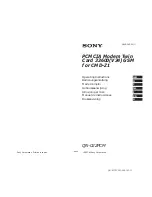
5
1 - 8 7 7 - 8 7 7 - 2 2 6 9
w w w . b l a c k b o x . c o m
M D R 2 9 X S E T T I N G S
5
S E T T I N G S
1) Client/Server: Designates MDR29x type. In each network, there must be only one Server. All other
MDR29x units must be programmed as Clients. The number of Clients in the network is not limited;
however, if performance diminishes, consider additional RF Networks.
2) Interface Baud Rate: This defines the baud rate used for communicating with the MDR29x over the
serial interface. The RF baud rate is fixed at 76.8 Kbps and is independent of the Interface Baud Rate. The
default baud rate setting is 57600 bps unless the units have been pre-configured by Black Box. The
Interface Baud Rate setting of the MDR29x must match the Baud Rate setting of its host device.
3) Channel Number: A number that designates an independent network of MDR29x units. Up to 32
independent networks can be created. The valid range of values for this field is 16 to 47.
4) Max Transmit Retries (For Clients and Servers in Point-to-Point networks only): This value
represents the maximum number of times a particular data packet will be transmitted unsuccessfully, or
without an acknowledgement, before the MDR29x discards the packet. The default value is 16 attempts. If
communication is lost and the Client's Link LED is on, try increasing this value in small increments until
communication is reestablished.
Note: This value is always associated to Client radios and Server radios in Point to Point Mode. The valid
range of values for this field is 1 to 255.
5) Broadcast Attempts (For Servers in Point-to-Multipoint networks only): This value represents
the number of times a data packet will be transmitted by the Server MDR29x. The default value is 4
attempts. If communication is lost and the Clients' Link LED is on, try increasing this value in small
increments until communication is reestablished. The valid range of values for this field is 1 to 255.
6) System Identification: A number from 0 to 256 that provides added security to each independent
network of MDR29x units. The System ID is used in conjunction with the Channel Number and serves as an
RF password to maintain secure transfers of data. The combination of the Channel Number and System ID
must be unique to each network of MDR29xs to establish communication. Multiple Servers in the same
coverage area must be programmed with different Channel Numbers to prevent inoperability of the
networks. The System ID will not prevent inoperability that occurs from locating multiple Servers with the
same Channel Number in the same coverage area.
Note: Separate Collocated MDR29x networks must operate on different Channel Numbers. All units in a
given MDR29x network must have identical Channel Numbers and System IDs.
7) Data Encryption Key: Encryption is the process of encoding an information bit stream to secure the
data content. The DES algorithm is a common, simple and well-established encryption routine. An
encryption key of 56 bits is used to encrypt the packet. The receiver must use the exact same key to
decrypt the packet; otherwise garbled data will be produced.
8) Destination Address: The MAC Address of the remote MDR29x in a Point-to-Point network. Used to
optimize Point-to-Point communications by utilizing RF Acknowledgement.
9) Firmware Version: Displays the MDR29x's firmware version.
10) MAC Address: A unique 6 Byte, IEEE 802.3 Ethernet address assigned by Black Box to each MDR29x.












































